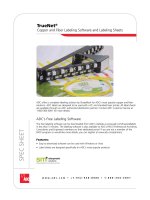Monitors and Sound Systems docx
Bạn đang xem bản rút gọn của tài liệu. Xem và tải ngay bản đầy đủ của tài liệu tại đây (566.73 KB, 26 trang )
Monitors and Sound
Systems
lesson 5
This lesson includes the following sections:
•
Monitors
•
PC Projectors
•
Sound Systems
Monitors
•
Categories of Monitors
•
CRT (Cathode Ray Tube) Monitors
•
Flat-Panel Monitors
•
Comparing Monitors
•
Video Controllers
Monitors - Categories of Monitors
Monitors are categorized by the technology they use:
•
Cathode ray tube (CRT) monitors
•
Flat-panel displays
And by the way they display colors:
•
Monochrome – One color on a black background
•
Grayscale – Shades of gray on a white or off-white
background
•
Color – From 16 to 16 million unique colors
Monitors - CRT Monitors
•
In CRT monitors, electrons are fired at phosphor
dots on the screen.
•
The dots are grouped into pixels, which glow when
struck by electrons.
•
In color CRTs, each pixel contains a red, green, and
blue dot. These glow at varying intensities to produce
color images.
Monitors - Flat-Panel Monitors
•
Most flat-panel monitors use liquid crystal display
(LCD) technology.
•
Passive matrix LCD uses a transistor for each row
and column of pixels: less expensive, narrow viewing
angle, submarining (animated graphics blurry)
•
Active matrix LCD uses a transistor for each pixel on
the screen: expensive, wider viewing angle, faster
refresh
•
Thin-film transistor (TFT) displays use multiple
transistors for each pixel.
Flat-panel monitors take up less desk space;
less radiation
Monitors - Comparing Monitors
When comparing monitors, consider four features:
•
Size
•
Resolution
•
Refresh rate
•
Dot pitch
Comparing Monitors - Size
•
A monitor's size is the diagonal measurement of
its face, in inches.
•
For years, 15" monitors (13"viewing area) were
standard.
•
Today, 17" monitors (15" viewing area) are common.
•
Larger monitors are available, but can be expensive.
The diagonal
size (often 15”)
Comparing Monitors - Resolution
•
Resolution is the number of pixels on the screen,
expressed as a matrix (such as 600x800).
•
A 17" monitor offers resolutions from 640x480 up to
1280x1024.
•
The Video Graphics Array (VGA) standard is
640x480. Super VGA (SVGA) monitors provide
resolutions of 800x600, 1024x768 or higher.
Resolution (image sharpness) is important.
(Especially for graphics, page layout, and CAD (Computer
Aided Design))
Comparing Monitors - Refresh Rate
•
Refresh rate is the number of times each second that
the electron guns scan the screen's pixels.
•
Refresh rate is measured in Hertz (Hz), or cycles per
second.
•
Look for a refresh rate of 72 Hz or higher. A slower
rate may cause eyestrain.
Fast scanning = Quick refresh (less flicker)
Comparing Monitors - Dot Pitch
•
Dot pitch is the distance between the phosphor dots
that make up a single pixel.
•
In color monitors, three dots (red, green, and blue)
comprise each pixel.
•
Look for a dot pitch no greater than .28 millimeter.
Fine dot pitch = Crisp displays
R + BB + G
R + G
R + B + G
Phosphor Dot Color Mixing
R: Red, G: Green, B: Blue
Monitors - Video Controllers
•
The video controller is an interface between the
monitor and the CPU (Central Processing Unit).
•
The video controller determines many aspects of a
monitor's performance, such as resolution or the
number of colors displayed.
•
The video controller contains its own on-board
processor and memory, called video RAM (VRAM).
VRAM
Graphic intensive applications such
as games require plenty of VRAM.
Video Control Board
with Monitor Cable
PC Projectors
•
A PC projector connects to a PC and is used to
project images on a large screen.
•
Many PC projectors provide the same resolutions and
color levels as high-quality monitors.
•
Digital light processing (DLP) projectors use a
microchip containing tiny mirrors to produce very
sharp, bright images.
Projected
Screen
Sound Systems
•
Multimedia PCs come with a sound card, speakers,
and a CD-ROM (Compact Disk-Read-Only
Memory) or DVD (Digital Versatile Disk) drive.
•
A sound card translates digital signals into analog
ones that drive the speakers.
•
With the right software, you can use your PC to edit
sounds and create special sound effects.









